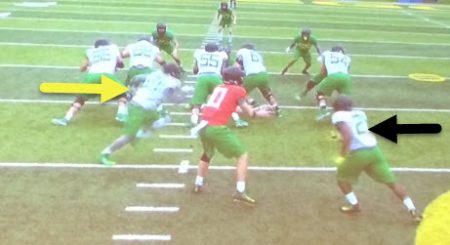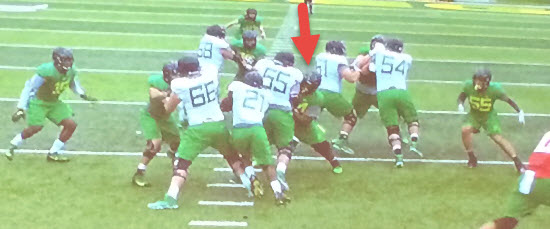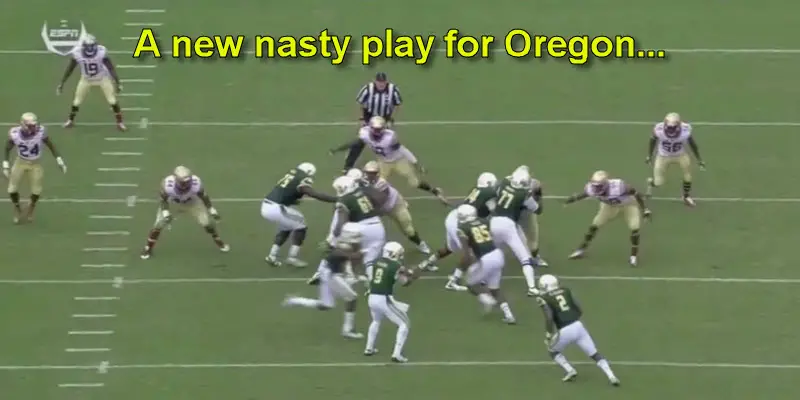This is going to be the most interesting Spring Football Game since Oregon converted to the spread offense a dozen years ago in 2005, and I simply cannot wait. I really should be more mature about this instead of breathlessly panting like a 13-year-old talking about an upcoming rock concert, but I cannot help it. I am Oregon.
As I wrote recently, we usually have three or four major story lines to follow going into the Spring Game, but this year it is closer to 30 to 40 story lines instead, and it is so fascinating to watch it all unfold. Defensive coordinator Jim Leavitt’s defense is unlike anything we have had at Oregon, and we will begin to digest the differences and impact on the Ducks’ future over the spring and summer. Coach Willie Taggart’s offensive attack is a fast, deceptive power game set up in a spread offense; this is not your Chip Kelly offense, and it will be delicious to consume …
I am in the unique position of being an intense fan and also one who has studied the Oregon offense and defense (with the help of a ton of coaches) like few in the media. I was going to write an article pointing out what you, as fans, should watch for, but screw it … I’m going to review what I’m personally going to be watching for while at the Oregon Spring Game and replaying it in slow-motion at my man cave in Eugene.
First — get acquainted with the fundamental component of the new Oregon offense, which is deception and threatening the defense first with speed (shown in the clip above). It comes in the form of the jet sweep, and while Oregon has done it with De’Anthony Thomas in the past, it is not an occasional play in Taggart’s attack. This component has the eyes of defense on it as it must when Tony Brooks-James, Taj Griffin, or Darren Carrington is running it.
As if the jet sweep is not enough of a threat, Oregon will run a counter trey the other direction (above) with either a running back or quarterback following the pulling linemen. The defense will then have threats pulling them two directions as Oregon engages in speed and power running at the same time.
This concept extends beyond what we can cover here as Oregon has a quarterback power, where the quarterback pulls the ball from the jet sweeper and follows him to the right for a big gain, or he can pull up and throw the bubble screen to the outside. At the recent Spring scrimmage at Jesuit High School … I noted how the defense was fixed at the line of scrimmage defending the jet sweep and the power running from the counter trey and then the tight end Jacob Breeland, No. 27, would slip downfield behind the defense for massive play-action passes and easy touchdowns.
Yes — that is five threats attacking the defense in five different sectors of the field from this jet sweep series, and that is all that has been revealed as yet!
Above is a new play that has swept the country and was used by both Clemson and Alabama in their playoff games; the toss read is a new variation of the older inverted veer and was seen in two Oregon scrimmages held for the public thus far. See if you note the quarterback ever holding the ball and running, or if the “pitch” man is truly the only option with this play.
A Major Change of Philosophy on Offense …
You will see a couple of items not done at Oregon in a very long time, such as how the offensive line is no longer looking to “chip” a defender and go downfield to deliver another block. Instead, look for offensive linemen trying to finish their blocks that take place in the “box” whether it be defensive linemen or linebackers. This can mean mauling someone when an advantage is gained, as some toughness is being instilled in the offensive line. The philosophy is to be certain of completing your blocks in the box. Thus, if a running back is in the secondary, he would have the room to make defenders miss …

The yellow arrow is the “Jet” while the black arrow is Royce Freeman.
You will also see some combinations in plays before that have not happened since the 2007 Sun Bowl and maybe not even then as you will see the inside zone read and the jet sweep paired in the same play.
Why would they do that? If you are coaching the defense, how would you like to defend Royce Freeman going one way, and a jet such as Brooks-James going the other direction? You must cover both, with the result being huge stresses placed on opposing defenses.
A Most UNUSUAL Defense To Be Unveiled …
You will see a different alignment on defense, as this site announced a defensive change two weeks ago that no one else in the Oregon media noted, and we are re-running that section of the article again, so we all know what to watch for on Saturday.
FishDuck.com contributor Coach Mike Morris, made an observation watching Colorado game film. The Ducks’ base defense is now a nickel defense, and not a 3-4 after all, but a 3-3-5. This is a very different defense from what we believed was coming to Oregon.
Khalil Oliver and Fotu Leiato have been first- and second-string nickel backs and reported as “Duck” linebackers by GoDucks.com. The nickels “flip flop,” always lining up on the wide side of the field, while the other outside linebacker (Jimmie Swain and Jonah Moi) also flip flop, lining up as a stand-up defensive end. So it looks like/is a “50 front,” but with 3-3-5 personnel.

Leavitt’s 3-3-5 Defense — The red arrows are the linemen with a hand down, then LBs (green arrows) and defensive backfield marked by yellow arrows.
My opinion is this is due to “matching,” meaning if the offense comes out with three receivers or more, the nickel defense personnel will be in the game.
Most teams on the schedule, with the exception of Stanford, run 3-WR-plus sets, so I expect the nickel personnel will be on the field the majority of the time to cover the extra receivers. This is a big reason why this year Dye was moved from outside to inside “Will” backer. In this position, he can stay on the field to cover tight ends and running backs when offenses go to more passing personnel. As a coach you do not want linebackers to cover receivers very often.
When Oregon runs an “even” 4-2 front on passing downs, they substitute an OLB as a pass-rushing DE, for the NT. (That will probably change with the addition of graduate transfer Scott Pagano.) Colorado also flipped their linebackers, making them a “Mike” and “Will” instead of left and right linebackers, and this will be interesting for all to observe in the Spring Game as well.
A Critical New Component To Leavitt’s Defense

Jordon Scott, (red arrow) jams up the LOS to allow the linebackers to fill the gaps easier!
Something that Oregon struggled with the last time the Ducks ran a 3-4 defense was the absence of a big plugger in the middle as a nose tackle who would need to be double-teamed.
Colorado had an ideal one last year at 320 lbs., and Oregon got an early present for football season when Jordon Scott showed up early to be in Spring football as a true freshman. He has shown in practice to have superb strength and has adopted the correct form from defensive line Coach Joe quite well. See if he gives the centers trouble in a more game-like atmosphere!
As always — my Oregon cup runneth over when I am writing about my beloved Ducks. Do watch for these changes, and I will provide some commentary about the game in a Sunday morning article.
Here is to a great Spring Game with no injuries! Go Ducks!
Charles Fischer (FishDuck)
Eugene, Oregon
Top Photo from Video
Related Articles:
Oregon Enters Playoffs Better Off Than Last Year
Will The Coaching Carousel Kill Oregon's CFP Chances?
The Playoff Formula Hasn't Changed
Oregon Aims to Bury Dawgs, Punch Playoff Ticket in Rivalry Clash
Huskies Are the New Beavers, Stay In Your Lane Kiffin, and the Civil Apple Cup War
Oregon Football: The X-Factor Vs. Washington

Charles Fischer has been an intense fan of the Ducks, a season ticket holder at Autzen Stadium for 38 years and has written reports on football boards for over 26 years. Known as “FishDuck” on those boards, he is acknowledged for providing intense detail in his scrimmage reports, and in his Xs and Os play analyses. He is single, has a daughter Christine, and resides in Eugene Oregon where he was a Financial Advisor for 36 years.
He now focuses full-time on Charitable Planned Giving Workshops for churches and non-profit organizations in addition to managing his two Oregon Football Websites, of FishDuck.com and the Our Beloved Ducks forum. He is a busy man!
He does not profess to be a coach or analyst, but simply a “hack” that enjoys sharing what he has learned and invites others to correct or add to this body of Oregon Football! See More…

